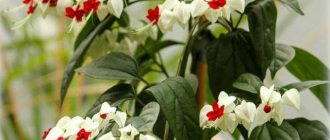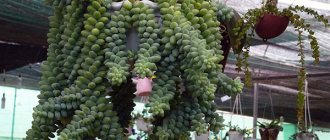What is it: description and types with photos
A bright indoor representative of the extensive Gesneriaceae family is Streptocarpus. Its homeland is South Africa, the island of Madagascar and the southern coast of Asia, and it prefers to grow on rocky mountain slopes.
Streptocarpus are divided into simple non-hybrid and hybrid forms.
Modern hybrid streptocarpus are stemless herbaceous plants for indoor cultivation . The leaves are green and variegated in color, elongated in shape, collected in a basal rosette, and their size can reach up to 30 cm. Streptocarpus also differ in the number of leaves, for example, some are multi-leaved, while others have only one leaf.
Streptocarpus flowers are bell-shaped, located on peduncles 25 cm high, and can be either simple, double or semi-double. They also differ in diameter - from 2 to 10 cm. Small flowers grow in large numbers on the peduncle, while giant flowers grow in only a few pieces.
The flowers are colorful, including white, yellow, and various shades of red, blue and purple, and even almost black. There are hybrids with two-color flowers covered with a dotted or dashed pattern. Fantasy hybrids have an unusual blurry color of flowers from 4 shades . The petals vary in shape, with rounded or wavy edges.
At the moment, more than 120 species of this plant are known.
Rex
Its 25-centimeter leaves are pubescent, and the bright lilac flowers are decorated with purple shading inside .
Rocky
A perennial plant with a woody, strong base, the ends of the shoots are curled, and the light green leaves of a small oval shape are pubescent. Purple flowers bloom in summer and fall.
Wendlanda
With one large, wide oval leaf up to 90 cm long, pubescent and wrinkled, like most streptocarpus. The leaf blade is green on top with light veins, and on the back side it is red-lilac. Purple-blue flowers grow up to 5 cm in diameter, 15 pieces on one peduncle. This streptocarpus dies after flowering and reproduces only by seed .
Stem-forming
Characterized by pale blue flowers.
Hybrid large-flowered
A small herbaceous plant grows up to 30 cm and has large, wrinkled, matte-shiny, elongated leaves.
Description of different types
Streptocarpus are divided into 3 types:
- Plants with one leaf and flower stalks . This type includes Wendland streptocarpus (Streptocarpus wendlandii). It’s not an acquired taste – a rare, original and very exotic flower! A single leaf of a flower spreads out of the pot like a green blanket, although it is not a leaf at all, but a cotyledon. This miracle leaf grows continuously and sometimes grows to almost a meter in length. It is wrinkled and densely covered with hairs. The top of the leaf blade has a rich emerald hue, and the back of the leaf is purple. This streptocarpus blooms in the second year. Peduncles on a tall, up to 70 cm, stem unwind one after another, like the leaves of a fern. Tubular flowers of interesting colors: blue-violet petals with white striped patterns on the throat. This streptocarpus has such an unpleasant feature - it is monocarpic, that is, it blooms and bears fruit only once in its life. Then he dies. If during its flowering you manage to pollinate it, collect the ripe seeds, plant it again and grow a new specimen - you will have something to be proud of!
- Creeping representatives of streptocarpus belong to the stem type . They creep along the ground like violet trailers and bush abundantly. They bloom profusely with small flowers (the variety Streptocarpus Kirka has 15 cm in height and small light purple flowers, and the variety Streptocarpus stemforming has a height of up to 60 cm and blooms with light blue small flowers).
- Most hybrid varieties are stemless plants that form rosettes of leaves. These are terrestrial and epiphytic species of streptocarpus. These include: royal (Streptocarpus rexii), Primulifolis, Johannis and many others, producing many large flowers formed in a rosette.
This may be interesting: Methods for propagating Violets (Saintpaulium)
Let us introduce you closer to Streptocarpus royalis or Rex. It is a herbaceous plant with a very short stem. The leaves grow up to 25 cm in length and up to 5 – 7 cm in width. They have an elongated lanceolate shape, their edge is crenate-toothed. The leaves are completely pubescent. Peduncles extend from axillary leaf buds to a height of up to 25 cm, one or two at a time. Flowers in nature are usually painted in pale lilac tones; there are rich purple stripes on the tube and throat. In hybrid varieties, bell-shaped, five-petal flowers are painted in a variety of colors: white, pink, red, purple. Moreover, they are decorated with two and even three colored patterns.
At home, hybrids of rosette-type indoor streptocarpus are most often grown, since they do not require much space and feel great on window sills.
Varieties of varieties
- The stem or multi-leaf type is a creeping plant that blooms profusely with miniature flowers.
- Rosette type is a hybrid variety with large flowers collected in a rosette. Flower growers prefer this type of plant, since most of them have wide, well-developed leaves with a wrinkled surface, in the axils of which no more than 2 peduncles grow.
- The single-leaf type is a powerful plant with a leaf reaching up to 100 cm in length and 60 cm in width. Some varieties of this type may grow several underdeveloped additional leaves.
Beneficial features
Streptocarpus cannot be called a poisonous plant, but science and medicine are still unknown about its beneficial properties.
With large buds
The second group of rosette varieties includes plants with large flowers from 7 to 10 cm.
Frost patterns
Gorgeous large (7-8 cm) flowers with bright, juicy and at the same time delicate colors . There is a thick purple mesh against a white background of corrugated petals. The center of the flower is a magnificent combination of pure white and purple. The leaves are wavy.
Kalahari
Contrasting bright flowers 7.5 cm in diameter. The upper petals are deep purple, the lower petals are light yellow with a faint purple mesh.
Hermann
Medium flowers (7-7.5 cm), upper petals are lilac-colored, lower petals are burgundy mesh and lilac edged on a cream background.
Pink dreams
The variety belongs to the colorful group . Petals with a corrugated edge, pink. The lower petals are with a juicy mesh the color of ripe raspberries on a light background. The flower is large (9 cm). Compact rosette of leaves.
FIFA
Fancy, exquisite flowers (7-8 cm), the upper petals are deep pink, the lower ones are with a crimson mesh and the same edge on a white background. Long-flowering.
Pool
Magical, even fatal-looking flower 7.5-8 cm . Petals are corrugated, cosmic deep dark violet with light specks on it. The look is captivating – you can’t look away.
Hypnosis
There really is something psychedelic about the flowers of this variety! On a thick, almost black, background there are bright splashes of crimson and lilac. The neck of the flower is white. Flower 7-8 cm.
Chick
Petals with ruffled edges . Flowers are 7.5 cm in lemon color, with a light center with light splashes of lilac.
Black Swan
Magically bewitching, catchy large flower (8-9 cm). Wavy velvet petals are dark purple, with a slant towards black purple.
Strawberries
Large flower 7-8 cm. Densely speckled petals: strawberry on white. Breathtaking beauty!
Caucasian captive
An easy and well-flowering variety with strong peduncles and large, 8-9 cm, flowers. The upper petals are deep pink, the lower petals have a coarse raspberry-lilac mesh on a light background. White neck with yellowish stripes below.
Young lady
Subtle pink color on top and lower white petals with red mesh. Flower size 8 cm.
Waterfall
The upper petals are violet flounces, the lower ones are with a violet mesh on a white background. Flower size 7-8 cm .
Avalanche
Very large (9-10 cm in diameter) snow-white corrugated flowers.
WaT bird
Variety by Tatyana Valkova. Looks like a flower from a fairy tale! Large flowers 8 cm in diameter. The light, monochromatic upper petals contrast beautifully with the lower petals, with a rich purple mesh that turns into a thick solid tone closer to the neck. The petals have a golden corrugated border.
Draco
Really looks like a dragon! The upper petals of a large flower (7-8 cm) are of a calm pink hue, but the lower petals are in golden and purple fiery tones.
Dimetris
Whimsically ruffled, heather-colored petals , the lower ones with a purple mesh on a yellowish background.
What should the temperature and humidity be?
For these light-loving plants, soft, diffused light is preferable; for this, it is preferable to place flowers on eastern and western windows. The temperature in summer ranges from +20 to +25 degrees, and in winter – not lower than +15 degrees.
For year-round development of streptocarpus, it is recommended to use special lamps for additional lighting, this is especially important in the autumn-winter period. The length of daylight for a flower should be at least 13-14 hours to ensure better flowering.
Streptocarpus needs a comfortable indoor humidity level of 60% to 75%.
Sowing
It is better to germinate seeds in low containers, having previously laid drainage under special loose soil. Planting occurs on the surface of the earthen mixture. Containers are covered with glass or film. From plants planted with seeds, the first flowers appear after 11 months.
In addition, streptocarpus are capable of self-pollination . Almost all flowers produce a spiral-shaped seed capsule, which turns brown after 2 months, and then the fruit opens on its own, scattering the seeds in different directions.
Reproduction by leaf fragment
This fragmentary leaf propagation has some complexity, but it is a fairly popular method. The spring season is optimal for propagation.
- A well-developed, preferably young, leaf is separated from the plant and cut with a clean, sharp tool perpendicular to the central vein, forming pieces 5 cm wide. It is quite possible to get more than 10 children from one such fragment.
- The fragments are planted 8 mm deep into the ground, leaving a distance of at least 3 cm between each other, and covered with film. Babies appear within 2 months. They will then need an additional few weeks of growth to separate them from the leaf.
More information about how to propagate streptocarpus with a fragment of a leaf is described in this video:
You will find more information about the reproduction of streptocarpus in a separate article.
Excerpt characterizing Streptocarpus
“I am very, very grateful to you, ma chere or mon cher [my dear or my dear] (ma chere or mon cher he said to everyone without exception, without the slightest shade, both above and below him) for himself and for the dear birthday girls . Look, come and have lunch. You will offend me, mon cher. I sincerely ask you on behalf of the whole family, ma chere.” He spoke these words with the same expression on his full, cheerful, clean-shaven face and with an equally strong handshake and repeated short bows to everyone, without exception or change. Having seen off one guest, the count returned to whoever was still in the living room; having pulled up his chairs and with the air of a man who loves and knows how to live, with his legs spread gallantly and his hands on his knees, he swayed significantly, offered guesses about the weather, consulted about health, sometimes in Russian, sometimes in very bad but self-confident French, and again with the air of a tired but firm man in the performance of his duties, he went to see him off, straightening the sparse gray hair on his bald head, and again called for dinner. Sometimes, returning from the hallway, he walked through the flower and waiter's room into a large marble hall, where a table for eighty couverts was being set, and, looking at the waiters wearing silver and porcelain, arranging tables and unrolling damask tablecloths, he called Dmitry Vasilyevich, a nobleman, to him. who was taking care of all his affairs, and said: “Well, well, Mitenka, make sure everything is fine. “Well, well,” he said, looking around with pleasure at the huge spread-out table. – The main thing is serving. This and that...” And he left, sighing complacently, back into the living room. - Marya Lvovna Karagina with her daughter! - the huge countess's footman reported in a bass voice as he entered the living room door. The Countess thought and sniffed from a golden snuffbox with a portrait of her husband. “These visits tormented me,” she said. - Well, I’ll take her last one. Very prim. “Beg,” she said to the footman in a sad voice, as if she was saying: “Well, finish it off!”
Keeping at home
The procedures for caring for the plant are simple:
- Humidity . The best option to achieve the desired result is spraying flowers. It is better to carry it out with small splashes of boiled water in the evening. In this case, water should not get on the leaves of the plant.
- Feeding . The plant should be fertilized carefully and regularly with a frequency of at least 2 times a month. Feeding for flowering plants will help accelerate the growth and flowering of streptocarpus, and also strengthen its immune system.
In summer, it is advisable to move the flower to a cool place, or to ensure stable air exchange without drafts.
Streptocarpus: watering
The plant needs not only good watering, but also high humidity. It should be sprayed regularly with water. In this case, you should ensure that water does not get on the leaves and flowers. Therefore, it is better to spray the air space around the streptocarpus or place a humidifier nearby. Spraying the flower is carried out once a week.
Sreptocarpus does not tolerate hard water well. Therefore, purified water should be used for watering them. At the same time, softening water using ion exchange filters is not permissible, since such filters replace calcium with sodium, which has a bad effect on the growth and development of the plant.
Streptocarpus at home
Flowers can be watered with water using reverse osmosis filters with the addition of complex fertilizer. Approximately 20-30 grams of fertilizer per 100 liters of water. Fertilizer is added to purified water not only for the purpose of minimal feeding, but also to eliminate the osmotic impact on the root.
You should not water with distillate. If this is done, then the increased osmotic pressure of external water directed into the flower crop can disrupt the integrity of the tissues. At the same time, the risk of waterlogging is much higher than watering with a minimum amount of fertilizer.
Streptocarpus tolerates drought well
But after the earthen clod has become very dry, the plant should be watered with caution, trying not to over-moisten the substrate. Since the roots will intensively absorb moisture at first
When the rainy season and cold weather arrive, the air in the apartment is naturally humidified, which reduces the need for watering. And, conversely, with intense lighting, when the plant grows quickly and actively blooms, the crop’s need for moisture increases. Watering and air spraying should be done more often.
When caring for streptocarpus, there is no specific schedule for watering plants. Watering should be done based on the condition of the soil. The substrate should be dry around the edges and remain moist in the middle.
When to replant and how to do it correctly?
The root system of plants rapidly develops and grows, occupying the entire volume of the pot. Due to the nature of active growth, young streptocarpus must be replanted twice a year in a pot 2 cm looser than the previous one . They are usually replanted for the first time closer to spring, and for the second time approximately six months later.
When replanting, it is customary to completely replace the old soil, since the soil is deprived of its nutrients due to such a long flowering period. A drainage layer must be placed at the bottom of the pot. It is better to choose pots that are spacious and low, preferably made of plastic.
More information about streptocarpus transplantation is described in this video:
Features of cultivation
- The plant likes to be in rooms with good lighting. You may need illumination with a special spectrum lamp.
- Room temperature from 15 to 25 degrees. Air humidity is up to 70%; you can install a humidifier next to the pot.
- Watering is not abundant, usually the flower clearly warns that it is time to water it, the leaves begin to wither.
- It is necessary to fertilize frequently, since watering washes out nutrients, and abundant flowering depletes the soil.
When properly grown streptocarpus at home, the flower will decorate your interior and delight the eye for almost a whole year.
Rooting with a leaf fragment
It is irrational to take a whole leaf for planting; a fragment of about 6 cm in size is absolutely sufficient. The recommended temperature for successful rooting is +20 – +22 degrees.
Sometimes the planted parts of the leaf lose their elasticity outwardly, but after rooting, which occurs within two months, they again acquire a fresh appearance.
Babies appear in 1.5 - 2.5 months . When the baby has reached a size of 1-2 cm, it can be separated from the planted leaf. At the same time, the “baby” often consists of only one leaf with roots, but is already quite capable of living independently, but it is better to keep it in a greenhouse for 3-4 weeks. If the separated babies are 5 cm or more in size, they do not need greenhouse conditions.
With small and medium flowers
The first group of rosette varieties includes plants with small or medium flowers from 5 to 7 cm.
Crystal lace
The creator of the variety gave the variety the exact epithet - “super ruffle” . The most delicate light lilac shade of the upper petals. The lower ones are a pleasant yellowish-fawn color with rich purple veins. The flower is 6.5 cm. The rosette is compact, small, the leaves are hard, not hanging.
Caramel
A very “appetizing” variety! Wavy petals, the upper ones in pink and white tones, the lower ones in soft caramel colors. The flowers are small (5-6 cm).
Picnic
The flowers are relatively small (6-7 cm), with blue mesh along the petals . Background: white on top, yellow on bottom. This variety is distinguished by the fragility of its flowers.
The Scarlet Flower
Small flowers (5-6 cm). As the name suggests, they are scarlet with a white core.
Hawaiian party
5-6 cm – flower size. A real tropical riot of colors, you can’t miss it! Double flowers with a wine-red mesh and juicy specks on a pinkish background.
Meteor Rain
Small wavy flowers (5-6 cm) , the top is blue with cream splashes, the bottom is the color of thick cream with a blue edge.
Swallowtail
Watercolor tints of pink and blue shades on the upper petals, below - a purple mesh on a creamy background. Flower diameter 7 cm.
Richelieu
The exact name of this variety is “Ruchelieu”. Indeed, these are flowers 6-7 cm in size, in romantic ruffles, in deep violet-blue tones and with a light center.
Lena
Double contrasting flowers from 6.5 to 7.5 cm . The upper petals are white with a purple mesh, the lower petals are juicy crimson.
Watering
Streptocarpus needs moderate watering, and it is contraindicated to overwater it, as this can lead to deformation of the plant.
Watering should usually be done once every 2 days. Top watering should be done carefully along the edge of the pot so as not to harm the flower buds. For bottom watering, the pot with the plant is placed in a tray with water.
Tap water is absolutely not suitable for irrigation ; you must use filtered water or water that has stood for several days, and best of all, rainwater.
Seeds: features and conditions for planting and germination
- Streptocarpus is germinated by seeds, but there is a high probability of loss of varietal characteristics. They can be sown at any time of the year.
- Seeds germinate in the light. Therefore, for those sown in the winter season, when daylight hours are shorter, additional illumination is required for 3–4 hours. However, it is preferable to sow in early spring.
- Seeds are sown in a flat container on top of the soil without covering them with soil. The container is covered with film or glass to obtain greenhouse conditions and is periodically ventilated. After 4 weeks, the canopy is gradually moved and removed.
- Shoots appear after 5-7 days. When two leaves appear, young shoots must be thinned out, and after reaching 2 cm in size, they can be planted in their own pots.
Learn more about how to grow streptocarpus from seeds in this video:
Unpretentious beauties - streptocarpus
I remembered the name “streptocarpus” for a long time))) But I liked the flower right away.
What can I do, I love beautifully flowering plants. Decorative deciduous trees somehow attract me less. I brought my first “...cactus”)) as a leaf from a business trip around the region. Here he is. The variety was called 'Texas Ice'.
First pet
Since streptocarpus are somewhat related to violets, they reproduce similarly. You root a leaf and a new pet is ready. They need the same soil. On bags of soil in the store, as a rule, it is written: “for violets and streptocarpus.”
Well, then I, as they say, “went wild”))) New handsome men began to appear systematically.
Bicolor 'Silva'
'Red Rose'
'Black magic'
The only drawback of streptocarpus compared to their violet relatives is their long leaves. Due to them, the flower requires more space. Violets in this sense are more compact.
Example of long leaves
But there are varieties that are more compact
I read advice on the Internet to simply shorten the leaves by trimming them with scissors. I tried it. Did not like. My beauties began to somehow wither and seem to get sick... I don’t do that anymore.
Bloom more luxuriantly without pruning
The peduncles of streptocarpus are also long, like the leaves. They appear at the base of the leaf from the central vein. I read that one leaf can produce up to a dozen flower stalks. My record is 6. A leaf that has aged and no longer produces flower stalks can simply be removed by carefully cutting it off at the base with a utility knife. Streptocarpus still continuously grows new leaves from the rosette.
A company of different varieties. It can be seen that all the flower stalks are elongated and long.
But they do not require a period of rest, unlike gloxinias, for example, and they can bloom continuously all year round))) They just change a little. With a lack of light, the flowers seem to turn pale and fade, and the leaves, on the contrary, become darker and seem to rise. They are probably trying to catch more light for photosynthesis.
Example
But in bright sunshine it’s the other way around. The flowers become brighter, and the leaves become lighter, lay down and unfurl.
'Black Magic' looks dark burgundy in bright light...
Although, of course, no one has canceled the varietal characteristics!
Different leaves for different varieties
In general, I won’t agitate anyone, but personally, I really like these flowers. Because they are unpretentious, because they bloom for a long time and almost continuously, because the variety of colors and colors always allows you to choose what you like!
Good luck to everyone!
Is a rest period necessary in winter?
Streptocarpus is quite capable of continuing to flower year-round. To do this, it needs to maintain a comfortable temperature, as well as a duration of lighting corresponding to the daylight hours.
As such, streptocarpus does not have a period of pronounced dormancy . However, it is recommended that young and immature plants take rest in the winter. For this you should:
- reduce the amount of watering;
- stop feeding;
- change the temperature and lighting.
This will establish a two-month rest period - from December to February.
Decorative advantages and popularity among florists
A large number of new varieties of this wonderful plant are distinguished by their incredible appearance and can decorate any home or small greenhouse, and florists use streptocarpus when composing luxurious compositions. Decorative advantages :
- New colors and unusual varieties of flower colors.
- Up to 10 peduncles from the axil of one leaf and abundant flowering.
- Rapid production of resistant hybrids.
- Easy to care for, unpretentious plant.
- With proper care, streptocarpus blooms all year round and is incredibly lush. Even after the end of the flowering period, the plant amazes with its amazing appearance.
Popular varieties of streptocarpus with photos of flowers
Charlotte Megan
Bicolor varieties in which the corolla and neck are distinguished by contrasting shades: (Streptocarpus Megan and Streptocarpus Charlotte).
Bristol's Party Girl
Fancy varieties whose petals are covered with netted patterns or completely spotted (Streptocarpus Bristol's Party Girl blooms with large dark blue flowers with a white eye). One of the authors is the famous US breeder Ralph Robinson.
Gwen Bethan
Daphne
Strawberry Crush
Varieties with unusual textural coloring of petals (Gven, Bethan, Daphne, Strawberry Crush).
Bristol's Phaser Blast Bristol's Luv It
Bristol's Leopard Skin
Varieties with two or even three tones (Bristol's Phaser Blast, Bristol's Luv It, Bristol's Leopard Skin).
Bristol's Very Best
Semi-double varieties (Bristol's Very Best).
Bristol's Red Lava
Bristol's DooWop
Terry varieties (Bristol's Red Lava and Bristol's DooWop).
Canterbury Surprise
Miniature and variegated varieties (Canterbury Surprise).
Below are the names of streptocarpus that received the British Royal Horticultural Society Award:
Albatross
Streptocarpus "Albatross" - with white flowers.
Crystal Ice
"Crystal Ice" - has white flowers with purple-blue veins, blooms all year round.
Chorus Line
“Cordeballet” (“Chorus Line”) is a terry variety with soft lilac veins on the petals.
Blue bells
Streptocarpus “Blue bells” - have corollas up to 10 cm in diameter of a beautiful blue color with a slight lilac tint.
Cynthia
"Cynthia" - blooms with bright pink-purple flowers
Falling Stars
"Falling Stars" - has violet-blue flowers. Flowering is abundant.
Gloria
Streptocarpus “Gloria” is a mutation of the “Shooting Star” variety, the flowers are a soft pink hue.
Heidi
"Heidi" - flowers have cream petals with a dark purple pattern on the lower three;
Jennifer
"Jennifer" - the violet-blue petals have darker veins.
kim
Streptocarpus "Kim" - flowers are dark purple, velvety, with a light center.
Ruby
"Ruby" - flowers of rich red color with a slightly pinkish tint.
Stella
"Stella" - has flowers with pale pink petals and burgundy veins.
Susan
Streptocarpus "Susan" - has pink-red flowers with a yellow center.
Salmon Sunset
"Salmon Sunset" - has simple flowers of a soft salmon color, the lower part of the neck is yellow with a burgundy pattern in the shape of a maple leaf. The flowers are not very large, but the flowering is abundant.
Alissa
"Alice" (Alissa) - has large bright yellow flowers. Flowering is long and abundant.
Bristols Pajama Party
Streptocarpus 'Bristols Pajama Party' - pink gramophone flowers with white stripes.
Texas Hot Chili
"Texas Hot Chili" is a compact, slow-growing variety with bright red flowers with a yellow eye.
Baltic Sea
Streptocarpus "Baltic Sea" - variety CF. It has large velvety blue-violet flowers with dark veins throughout the petals. The two upper petals are slightly lighter than the three lower ones. The neck is white with dark purple stripes in its lower part. The edges of the petals are wavy. Flowering is long and abundant.
Valentina
"Valentina" is a CF variety. It has huge bright lingonberry flowers with petals bent back.
This may be interesting: Types and varieties of Crossandra
Diseases and treatment
Streptocarpus is known for its resistance to various diseases and pests, however, if not properly cared for, the plant becomes vulnerable to the following dangers :
- Withered leaves in wet soil - rotting of the roots occurs. It is necessary to transplant the plant into new soil.
- Yellow, slightly wilted leaves mean sunburn, therefore, you need to change the place “under the sun” to a shady one.
- Drying leaf tips are a sign of a lack of moisture or a pot that is too cramped; appropriate measures must be taken.
- Growth has stopped - the pot is too voluminous.
- The plant does not produce young leaves - it is necessary to change the old depleted soil or add lighting.
- The growth of the plant has slowed down or stopped, there are silvery streaks on the foliage - thrips damage, spraying with insecticides will help.
- The foliage becomes covered with yellow spots, and after a while it falls off; a cobweb is noticeable between the leaves and the stem - a spider mite. Repeatedly spray the plant with chemicals, strictly adhere to the required dosage in the instructions.
- Shoots, buds and leaves suffer, growth is delayed or stops altogether, the plant does not develop - mealybug. Cleaning the plant from pests and treating it with a soap solution, after which the plant is sprayed with tobacco or garlic tincture, as well as calendula tincture.
- On the underside of the leaves, rather small brown warts—scale insects—become noticeable. They have a protective wax layer that does not allow chemicals to pass through, so scale insects are removed manually using a damp swab and then sprayed with an insecticide.
- The leaves become covered with dark mosaic spots - late blight or virus. It is almost impossible to cure a large plant.
Streptocarpus is a beautiful flowering plant, whose incredible appearance can decorate any apartment, and with proper care it will bloom for a very long time and incredibly lushly.
With huge buds
The third group of rosette varieties includes plants with huge flowers over 10 cm.
Mozart
Flowers are 10 cm in diameter. The petals are large ruffles, the color of the upper ones is violet-blue, the lower ones have a lilac border and veins against the background of the color of baked milk.
Margarita
A variety with huge (10 cm) flowers, colored in a thick red wine tone . Petals with large flounces.
Himalayas
One of the large-flowered varieties (10 cm). Transparent lavender upper petals and purple mesh on a light background below.
Siberia
The flower reaches a diameter of 12 centimeters! Let’s add to this the fantastic blue-black coloring of the giant flowers... It’s almost impossible not to gasp in surprise and fall in love!
Kata Tjuta
Record variety: flowers from 10 to 13 centimeters. Corrugated, scarlet on top, gold on the bottom with scarlet veins and border.
polar night
Huge flowers (12 cm). The color corresponds to the name of the variety : thick, violet-black velvet flowers with a soft lilac center.











